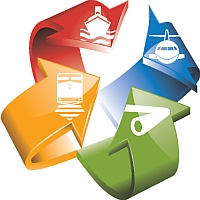Expanding the use of on-board voice and video recorders
Kirby Jang
Director of investigations, Rail/Pipeline, Transportation Safety Board of Canada
Ottawa, Ontario, 22 April, 2016
Check against delivery.
Slide 2: Outline
- Background
- Trenton Junction Investigation (R99T0017)
- Burlington Investigation (R12T0038)
- Watchlist – On-Board Voice and Video Recorders
- LVVR Safety Study
- Current Technology / Experience
- Assessment Methodology
- Preliminary Observations
- Concluding Comments
Slide 3: Background
No requirement for on-board voice and video recorders on locomotives.
Limited installations have been on a voluntary basis by railways.
Slide 4: R99T0017 – Trenton Junction
Train passed a signal that was indicating Stop.
Train travelled over a switch in the reverse position, and then came to a full stop.
No derailment, no injuries.
Slide 5: R99T0017 – Trenton Junction
What happened that day?
The signals worked as intended – So how were they missed.
Slide 6: R99T0017 – Trenton Junction
“Had the locomotive event recorder (LER) in the controlling locomotive cab been equipped with voice recording capability, it may have been possible to determine more definitely the effectiveness of the crew’s communications as they approached the occurrence location.”
Slide 7: Recommandation R03-02
The Department of Transport, in conjunction with the railway industry, establish comprehensive national standards for locomotive data recorders that include a requirement for an on-board cab voice recording interfaced with on-board communications systems.
Photo of the interior of a locomotive.
Slide 8: R12T0038
Photo of derailed train wagons.
Slide 9: Railway Signals
Photo of a train going towards railway signals.
Slide 10: The signals worked as intented
So how were they missed?
Image of a train station
Slide 11: Moving train
Image of a moving train
Slide 12: Findings as to Risk
The lack of locomotive in-cab voice and video recorders and forward facing video recorders deprives accident investigators of valuable sources of information that can enhance safety.
Slide 13: Recommandation R13-02
The Department of Transport require that all controlling locomotives in main line operation be equipped with in-cab video cameras.
Photo of the interior of the cabin of a locomotive.
Slide 14: Watchlist 2014
On-board Voice and Video Recorders.
With no requirement for on-board voice and video recorders on locomotives, key information to advance railway safety may not always be available.
Ensure that communications and interactions in locomotive cabs are recorded.
The TSB is committed to working with the regulator and the railway industry to explore ways of making progress on this issue.
Slide 15: CTAISB Act
- CTAISB Act restricts the use of on-board recordings to TSB investigations.
- Subsection 28(2) states that every on-board recording is privileged…
- Subsection 28(7) states that an on-board recording may not be used… in disciplinary proceedings, proceedings relating to the capacity or competence of an officer or employee …, or in legal or other proceedings…
Slide 16: Use of On-Board Recordings
- TSB Investigations:
- LVVR is essential for fully understanding the sequence of events and for examining crew actions and interactions.
- Expanded Use?
- TSB, TC and other stakeholders see value in expanding the use of on-board recorders for legitimate safety purposes within the context of SMS programs..
Slide 17: TSB / TC Joint LVVR Safety Study
- Assess the technology and operational aspects of LVVR.
- Demonstrate the safety benefits of this technology.
- Identify best practices.
- Identify implementation issues.
Slide 18: LVVR Safety Study – Project Tasks
- Technology Assessment
- Experience from the US.
- Experience from the other modes.
- Current Canadian experience.
- Common / Best Practices - Technology.
- Legislative & Regulatory Assessment
- Applicable Acts and Regulations.
- Privacy Concerns.
- Other Legal Issues.
- Implications for other modes.
- Operational / Human Factor Assessment
- Checklist for assessing On-Board Recordings.
- Triage and Detailed assessments.
- Common / Best Practices – Operational.
- Potential to evaluate Human Factors.
- Safety Benefits Assessment
- Benefits for TSB Investigations.
- Benefits for proactive safety management.
Slide 19: Current Technology / Experience
- Experience from the U.S.
- Freight Railroads
- Passenger / Commuter Railroads
- Federal Railroad Administration
- NTSB
- Experience from the other modes
- Aviation – CVRs
- Marine – VDRs
- Canadian Experience
- Locomotive Event Recorders
- Forward-facing video
- On-Board Voice & Video Recorders
- On-Board Voice Recorders
- On-Board Video Recorders
Slide 20: Locomotive
Photo of the interior of a cabine of a locomotive.
Slide 21: Locomotive
Photo of the interior of a cabine of a locomotive.
Slide 22: Assessment Methodology
- Elements to Consider
- Operational – Normal Situaiton
- Human Performance
- Operational – Non-normal Situaition L Locomotive Event Recorders
- Checklist for assessing On-Board Recordings
- Voice & Video Recordings
- Voice Recordings
- Video Recordings
- Scenarios of Interest
- Time of day
- High vs. low periods of work
- Starts vs. end of shift
- Additional Crew Members
Slide 23: Checklist for Assessing On-Board Recordings
- Crew Informaiton
- Number of people in cab
- Role of each crew member
- Crew interaction
- Crew Resource Management
- Capturing elements of human performance
- Stress
- Level of alertness
- Workload
- Situation awareness
- Distraction / Inattention
- Locomotive controls
- Coverage area
- Numerical readouts / position
- Inputs from crew members
- Responding to alarms
- Non-normal situations
- External detectors / alarms
- Emergency / Non-standard radio communications
Slide 24: Preliminary Observations
- Operational
- Voice & Video Recordings
- Voice Recordings
- Video Recordings
Slide 25: Concluding Comments
- Complete the LVVR Safety Study :
- Data collection completed.
- Analysis to be completed in April 2016.
- Final report to be prepared in May 2016.
- Next Steps :
- Circulate final report to stakeholders in all modes.
- TSB/TC discussions on “go-forward” plan.
Slide 26: Canada
Canada logo
